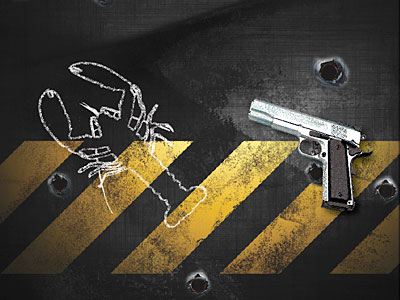February/March 2014 | view this story as a .pdf
One of every 100 people you pass on the streets of Portland may be concealing a handgun. Unless, of course, he isn’t concealing it.
By Colin S. Sargent
 At 8 p.m., 11-year-old Jesse Sweeney bursts through the door of a neighbor’s home in Casco, frightened and in tears. He has just seen his father wave his revolver and pull the trigger nine times, screaming, “Where’s the bullets?” His unemployed parents have been drinking and arguing since dinner. Jesse can’t stand the waiting anymore. He runs back outside to check on his mother and meets a ranting Gary Sweeney walking down the road, screaming, “I can’t believe it. How did that bullet get in there?”
At 8 p.m., 11-year-old Jesse Sweeney bursts through the door of a neighbor’s home in Casco, frightened and in tears. He has just seen his father wave his revolver and pull the trigger nine times, screaming, “Where’s the bullets?” His unemployed parents have been drinking and arguing since dinner. Jesse can’t stand the waiting anymore. He runs back outside to check on his mother and meets a ranting Gary Sweeney walking down the road, screaming, “I can’t believe it. How did that bullet get in there?”
The neighbors call 911.
At 4:30 a.m., Sweeney is arrested for manslaughter after a lengthy interrogation with state police. After 13 dry fires, Christine Pepin has been shot in the left side of the head with the 14th and final squeeze of the trigger.
State police detectives begin compiling evidence from the home where Sweeney and Pepin have spent their last 20 years. Police believe that Sweeney didn’t intend to kill his common-law wife, but instead just wished to wave the gun in her face.
Maine, with a population of about 1.25 million, lost 113 people through death by firearms in 1999, nearly twice as many as in all of Great Britain, where only 68 out of a population of 59 million died facing a gun. In France, the figure was 255 out of 59 million; in Germany, 381 out of 82 million. One hundred sixty-five Canadians suffered gun deaths out of 30 million. Japan, with 126 million, had 39 firearms-related deaths. Put another way, a citizen of Japan is 290 times less likely to die from a gunshot than a Mainer.
Maybe even more surprising is a direct comparison with New York, the “Goodfellas” state. The rate of firearm deaths in Maine, 9.0 in 100,000, is half again as high as the rate of firearm deaths in New York, 5.6 in 100,000.
“In my experience, there are more guns in Maine, in general, than in the rest of the nation,” says Portland police chief Michael Chitwood, who spent his early days on the streets of Philadelphia.
“In Portland, there are roughly 600 people with concealed weapons permits,” Chitwood says. “About one in every 100 people” you pass here on the street has a permit to pack a gun.
Bushmaster Firearms, at 999 Roosevelt Trail in Windham, manufactured the semi-automatic M-16 copy used in the 13 murders committed by the D.C. Beltway snipers in 2002. The very weapon they held in their hands was built in Windham, then sold directly to Bulls-Eye Shooter’s Supply in Tacoma, Washington, where it was later reported stolen.
Bushmaster, which pumps out almost 40,000 rifles a year, is not the only major arms manufacturer here. Smith & Wesson makes 20,000 pistols a year in Houlton, Maine. General Dynamics Armament Systems has a facility in Saco (formerly Saco Defense, Inc.) that is one of the world’s premiere manufacturers of M2 machine guns and automatic grenade launchers.
These ‘exotic’ weapons are generally not what kill Mainers, just as they are not generally what kill Americans. Chief Chitwood says,“The majority of Mainers who die in firearm-related deaths are killed by handguns.”
Handguns figure first in crimes, too.
“I have never seen a Kalashnikov. Long guns are sometimes confiscated, but they’re very rarely used in crimes.”
Confiscation occurs only in high-risk situations: when a concern about a mental illness leads police to believe a person may be a threat, when there is a danger of domestic abuse, when someone is reported to be a suicide risk, or whenever a gun is used in a crime.
“We confiscate around 100 guns a year, and most are not returned. Every three years or so, when we’ve built up a lot, we destroy them. During the last 10 years, we’ve destroyed around 1,000 weapons. We ship them off to get melted down and turned into boat anchors,” Chitwood says. “A fair amount of other [police] departments in Maine sell guns used in crimes at auction or to gun shops. They use them as a tool to plug gaps in their budgets.”
So who’s killing who? Mainers aren’t killing each other; we’re killing ourselves.
Eighty-one percent of Maine’s 113 firearm deaths were suicides.
“The most depressing firearm-related deaths we see are people killing themselves. People on impulse just shoot themselves in the head, in the mouth, or in the2chest, and that can be very hard on us. If people are bent on suicide, they’ll do it by any means–pills, hanging, drowning–but guns are the most effective. Our ‘successful’ suicide rate would be lower if it weren’t so easy.
“It’s important to realize that we live in a state in which gun violence is prevalent. I think people should have a right to bear arms, to hunt, to recreate with firearms, as long as they do it in a lawful way with common sense,” Chitwood says.
And if you think it’s a ‘gangsta’ thing coming in from larger urban areas, think again: Maine’s young people are emphatically not the ones who are dying from the shootings.
Below age 25, the number of young people dying in firearm-related crimes and incidents sharply drops to 5.6 in 100,000 from 11.5 in 100,000 for those above 25. Then who’s getting hit the most? People over 65: 13.7 in 100,000.
All but one of those firearm deaths for Maine senior citizens were suicides.
Maine has no registration laws and bans only those weapons banned nationally. The only limitation on gun ownership here is that a permit is required to carry a concealed weapon, and the only criterion for one of these permits is that an applicant does not have a felony record.
Even this can be waived. Any Mainer can buy a firearm and keep it at home without any state interference. No firearms safety course must be taken in order to receive a concealed carry permit. It’s easier to legally carry a concealed weapon in Maine than it is to drive to Cumberland Farms or fish for rainbow trout on Sebago Lake.
With Michael Moore’s recent documentary Bowling for Columbine earning international acclaim, Americans are asking what is behind firearm violence and what can be done about it. Is it a national disease?
Many Mainers’ livelihoods rest on perfectly legal target sports. Further north in Canada, a higher rate of gun ownership is coupled with a much lower rate of firearm deaths. Some think it is too easy to purchase a weapon and wave it in another’s face. “If I could write one law for Maine, it would be to require a waiting period for any kind of gun,” Chitwood says. “You have to wait for a driver’s license, for a passport, for a loan. Why shouldn’t you have to wait to buy a firearm?”
The opinions of Mainers on this sensitive issue vary widely across a state in which shooting sports are a multimillion-dollar industry. The largest problem with firearms violence in Maine, suicide, is considered to be a different issue by pro-gun and anti-gun groups. William Harwood, the President of the Maine Citizens Against Handgun Violence, says, “It’s tragic and depressing to lose more than 100 Maine citizens a year due to gun violence. Our firearms violence problem is in our homes: suicide and domestic confrontation. It’s challenging to try to reduce suicide, and suicide is a complex issue, but easy access to firearms is a significant contributing factor to the suicide rate in Maine. Firearms are a very easy way to commit suicide, and easy access to firearms can accelerate escalation of domestic issues.”
George Fogg, the former secretary of the Pine Tree State Rifle & Pistol Association, disagrees. “The majority of firearms deaths in Maine are suicides. In the United States, the tool that one most often uses for suicide is a gun. As Dr. John Macintosh says, “Once people make the final decision to commit suicide, the tool is immaterial. I just did some search for the Sportsman’s Alliance of Maine to put together a brief on guns and crime and violence in Maine, and we found that Maine does not have a problem with gun violence. Guns cause violence as often as matches cause arson.”
Police Chief Michael Chitwood left Portland in 2005 to become the superintendent of the Upper Darby, Pennsylvania, police department. A biography, Tough Cop: Mike Chitwood vs. the Scumbags by Hal Gullan, was published by Camino Books in 2013.
The Portland Police Department continues to destroy guns confiscated in the commission of crime. “We deliver them to places that turn them into boat anchors and manhole covers,” says Commander Gary Rogers. “An officer personally witnesses the destruction.”
Concealed-weapon permit applications skyrocketed in Maine in 2013. The Portland Press Herald recently reported Maine’s Public Safety Department issued “more than 11,000 permits,” up “from 7,500 in 2012.” This doesn’t include permits issued by police departments statewide, numbers the Public Safety Department doesn’t tally.
Portland Police Chief Michael Sauschuck provides City of Portland numbers that bear out the statewide trend. In 2011, 186 permits were granted; in 2012, 209; in 2013, the number rose to 276. “Before issuing a permit, a background investigation is conducted by the Internal Affairs Unit,” he tells us. “This involves a review of criminal history, any history of mental illness, or involvement in domestic violence. Each background investigation is reviewed by the Police Attorney prior to a final determination by the Chief if a permit will be issued.” He also notes that in 2013, “We denied 25 permits.”





0 Comments